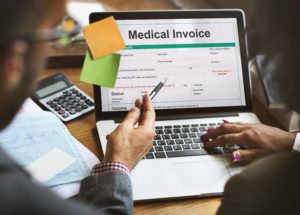 According to the U.S. Department of Health & Human Services (HHS), as announced in early April, a portion of the $100 billion Provider Relief Fund would be used to reimburse healthcare providers, at Medicare rates, for COVID-related treatment of the uninsured. As a condition, providers are obligated to abstain from “balance billing” any patient for COVID-related treatment. The Families First Coronavirus Response Act requires private insurers to cover an insurance plan member’s cost-sharing payments for COVID-19 testing. President Trump also secured commitments from private insurers, including Humana, Cigna, UnitedHealth Group, and the Blue Cross Blue Shield system to waive cost-sharing payments for treatment related to COVID-19 for plan members.
According to the U.S. Department of Health & Human Services (HHS), as announced in early April, a portion of the $100 billion Provider Relief Fund would be used to reimburse healthcare providers, at Medicare rates, for COVID-related treatment of the uninsured. As a condition, providers are obligated to abstain from “balance billing” any patient for COVID-related treatment. The Families First Coronavirus Response Act requires private insurers to cover an insurance plan member’s cost-sharing payments for COVID-19 testing. President Trump also secured commitments from private insurers, including Humana, Cigna, UnitedHealth Group, and the Blue Cross Blue Shield system to waive cost-sharing payments for treatment related to COVID-19 for plan members.
$50 Billion General Allocation
$50 billion of the Provider Relief Fund is allocated for general distribution to Medicare facilities and providers impacted by COVID-19, based on eligible providers’ 2018 net patient revenue. The initial $30 billion was distributed between April 10 and April 17, and the remaining $20 billion is being distributed beginning Friday, April 24.
- To expedite providers getting money as quickly as possible, $30 billion was distributed immediately, proportionate to providers’ share of Medicare fee-for-service reimbursements in 2019. On Friday, April 10, $26 billion was delivered to bank accounts. The remaining $4 billion of the expedited $30 billion distribution was sent on April 17.
- This simple formula used the data on-hand to get the money out the door as quickly as possible. The Administration was transparent and upfront additional funds would be going out quickly to help providers with a relatively small share of their revenue coming from Medicare fee-for-service, such as children’s hospitals.
- HHS will begin distribution of the remaining $20 billion of the general distribution to these providers on April 24 to augment their allocation so that the whole $50 billion general distribution is allocated proportional to providers’ share of 2018 net patient revenue.
- On April 24, a portion of providers will automatically be sent an advance payment based off the revenue data they submit in CMS cost reports. Providers without adequate cost report data on file will need to submit their revenue information to a portal opening this week linked on this page for additional general distribution funds.
- Providers who receive their money automatically will still need to submit their revenue information so that it can be verified.
- Payments will go out weekly, on a rolling basis, as information is validated, with the first wave being delivered at the end of this week (April 24, 2020).
- Providers who receive funds from the general distribution have to sign an attestation confirming receipt of funds and agree to the terms and conditions of payment and confirm the CMS cost report.
- The Terms and Conditions also include other measures to help prevent fraud and misuse of the funds. All recipients will be required to submit documents sufficient to ensure that these funds were used for healthcare-related expenses or lost revenue attributable to coronavirus. There will be significant anti-fraud and auditing work done by HHS, including the work of the Office of the Inspector General.
- As part of this commitment, a condition to receiving these funds, providers must agree not to seek collection of out-of-pocket payments from a presumptive or actual COVID-19 patient that are greater than what the patient would have otherwise been required to pay if the care had been provided by an in-network provider.
Additional Information on the Initial $30 Billion Distribution
Recognizing the importance of delivering funds in a fast and transparent manner, $30 billion is being distributed, with payments arriving via direct deposit beginning April 10, 2020, to eligible providers throughout the American healthcare system. These are payments, not loans, to healthcare providers, and will not need to be repaid.
How Does This Apply to Different Types of Providers?
All relief payments are being made to providers and according to their tax identification number (TIN). For example:
- Large Organizations and Health Systems: Large Organizations will receive relief payments for each of their billing TINs that bill Medicare. Each organization should look to the part of their organization that bills Medicare to identify details on Medicare payments for 2019 or to identify the accounts where they should expect relief payments.
- Employed Physicians: Employed physicians should not expect to receive an individual payment directly. The employer organization will receive the relief payment as the billing organization.
- Physicians in a Group Practice: Individual physicians and providers in a group practice are unlikely to receive individual payments directly, as the group practice will receive the relief fund payment as the billing organization. Providers should look to the part of their organization that bills Medicare to identify details on Medicare payments for 2019 or to identify the accounts where they should expect relief payments.
- Solo Practitioners: Solo practitioners who bill Medicare will receive a payment under the TIN used to bill Medicare
For updated details on the CARES Act Provider Relief Fund visit HHS.gov.